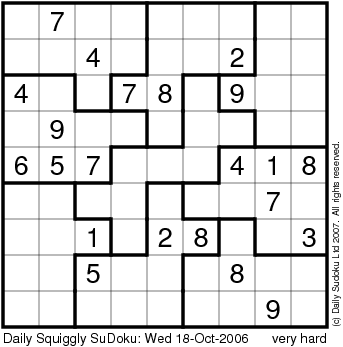| View previous topic :: View next topic |
| Author |
Message |
some guy
Joined: 18 Oct 2006
Posts: 1
|
 Posted: Thu Oct 19, 2006 12:49 am Post subject: Some very hard Squiggly Sudokus are mediums... Posted: Thu Oct 19, 2006 12:49 am Post subject: Some very hard Squiggly Sudokus are mediums... |
 |
|
Some "very hard" Squiggly Sudokus are "mediums", provided they are symmetrical enough. For example, the Oct. 18th puzzle:
http://www.dailysudoku.com/sudoku/play.shtml?year=2006&month=10&day=18&type=squiggly

If one superimposes the regular 3x3 box structure (orange lines), you get this:

(If the image doesn't appear, imagine there are orange lines separating columns 3 & 4, columns 6 & 7, rows 3 & 4, and rows 6 & 7. Cells r6c1, r6c2, and r6c5 are tinted green, and cells r7c4, r7c8, and r7c9 are tinted blue.)
Notice that there are an equal number of cells that "intrude" on either side of an orange line. In this case there are three pairs.
The three green cells must have the same three numbers as the three blue cells. If a candidate appears in one group, but not the other, it can be eliminated.
This pattern occurs at all four orange lines, but only one is illustrated here for the sake of simplicity
Solving the puzzle with basic techniques gets us here:

(r6c1=5, r6c2=34, r6c5=134, r7c4=46, r7c8=5, and r7c9=3.)
On row six, in the upwardly "intruding" cells (c1, c2, c5), there is the possibility of 5 (given), and 1, 3, & 4. On row seven, in the downwardly "intruding" cells (c4, c8, c9), there is the possibility of 5 & 3 (givens) and 4 & 6. Only the union of these two sets can be allowed in all six cells. This leaves 3, 4, & 5 as the only possible candidates for r6c1, r6c2, & r6c5, AND 3, 4, & 5 as the only possible candidates for r7c4, r7c8, & r7c9.
Elimination gets us this:

(Cell c7r4 is now 4, and cell c6r5 is now 34.)
Which allows the puzzle to be completed with more basic techniques.
This will also work with Squiggly puzzles with only one or two "intrusion pairs" "over the line", as long as they occur in pairs. That is one up, one down, or two up, two down, etc... Also ought to work with four pairs or more, but the technique may not eliminate enough to be useful.
This can also work if the "intrusion" is two rows or columns deep.
I don't know if this is a standard technique for Squiggly solving. I haven't seen anything like this, but I didn't search very hard. If it already has a name, what is it called? If it isn't named yet, I would call it "Squiggly intrusion elimination" or SIE.
P.S. I'm not sure if the images will appear properly, as I don't have a "real" place to post images. Hopefully viewers will be able to follow along by using the row and column positions.
Edit: I am now hosting the images on imageshack, so they ought to be visible now.
By the way, this technique works on the "very hard" April 4th Squiggly puzzle, rendering it much easier. If you check this link,
http://www.dailysudoku.com/sudoku/forums/viewtopic.php?t=610&sid=c4427dd2cece3ccd7589eae63374f18c
a poster named Steve R explains the underlying logic.
Basically, when symmetrical "intrusions" occur, certain candidates are forced to be in and out of certain places. |
|
| Back to top |
|
 |
sdq_pete
Joined: 30 Apr 2007
Posts: 119
Location: Rotterdam, NL
|
 Posted: Thu Jun 21, 2007 3:53 pm Post subject: Posted: Thu Jun 21, 2007 3:53 pm Post subject: |
 |
|
Isn't this the Left-Over Law (LOL)? This was discussed some months ago (in response to my questions) but the threads disappeared due to the server crash. Personally, I don't like the name Left-Over Law - I think "Subset Rule" would be better. Anyhow, I'm going to post a new thread on this topic in response to today's puzzle (21 June 2007).
Peter |
|
| Back to top |
|
 |
|
|
You cannot post new topics in this forum
You cannot reply to topics in this forum
You cannot edit your posts in this forum
You cannot delete your posts in this forum
You cannot vote in polls in this forum
|
Powered by phpBB © 2001, 2005 phpBB Group
|






